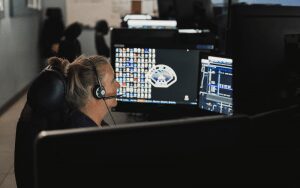Parking Your Vehicle
- Take your vehicle’s key; do not leave it in or on your vehicle.
- Close and lock all windows and doors when you park.
- Always try to park in well-lit areas if possible.
- Never leave anything in plain sight, not even empty bags or boxes. Conceal all navigation aids, cellular phones, audio systems, sunglasses, etc. inside your vehicle. Put cameras, packages, sports equipment, firearms, hand tools, and other valuables in the trunk before you park, never after you park because thieves may be watching. Take anything you can’t afford to lose with you, e.g., a wallet, purse, or laptop computer. Thieves usually don’t break into vehicles unless they plan to steal what’s visible inside.
- While walking to and from your vehicle, stay off of your cell phone or any other handheld device that will prevent you from remaining aware and observant of your surroundings .
- Walk defensively and be ready for unexpected events. Know what is going on around you and don’t allow your vision to be blocked by clothing, hats or items you are carrying.
- Watch your surroundings. Leave any places in which you are uncomfortable. Be especially alert for suspicious persons around banks, ATMs (Automated Teller Machines), stores, your home, etc.
- Consider your options in the event you are confronted, e.g., scream or blow a whistle to attract attention, flee to a safe area, etc. Decide what you plan to do and practice your responses so you can recall them in a real-life situation.
- Learn self-defense. Take classes only from licensed instructors. But don’t substitute self-defense training for common sense, alertness, and caution
In general, follow the four A’s of self-defense:
• Be AWARE of your surroundings and who or what is nearby.
• ASSESS the situation and possible threat.
• ACT quickly and decisively. Change your route, go into a store, use your voice, etc.
• Maintain a confident ATTITUDE. Don’t appear to be an easy target.
Vehicle Security
Vehicle Security:
There are numerous antitheft systems and devices designed to make vehicles more difficult to steal or easier to trace and recover. Here are how some of them work:
- Audible and Visible Devices: These devices, such as a horn alarm, deter theft by bringing attention to an unauthorized attempt to steal or enter a vehicle. Visible devices create a visual threat/warning/deterrence, such as the use of steering-wheel locks, as well as theft-deterrent decals, flashing lights, and window etching.
- Check your vehicle if you hear the alarm sound. But don’t try to stop a person attempting to break in. Get a good description of the person and call the police.
- When you lock your vehicle with a Remote Keyless Entry (RKE) fob make sure that all the doors are locked before leaving your vehicle, especially in public parking lots.
- Immobilizing-Type Devices: These prevent thieves from bypassing a vehicle’s ignition system and hot-wiring the vehicle. Some incorporate computer chips in ignition keys or disable the flow of electricity or fuel to the engine.
- Vehicle Recovery Systems: These devices use electronic transmission technology that help law enforcement reveal the location of stolen vehicles—and possibly catch the thief in the act.
If you are a victim of vehicle theft, follow these steps:
- Contact police immediately to file a stolen-vehicle report. You will need a copy of the police report and/or a case number to provide to your insurance company. You may also be asked to provide the following information: o License plate number;
- Make, model, and color of your vehicle; and
- Vehicle Identification Number (VIN) and any identifying characteristics.
Contact your insurance company to file a claim within 24 hours of your vehicle being stolen. If you find your vehicle before authorities do, contact the police immediately.














